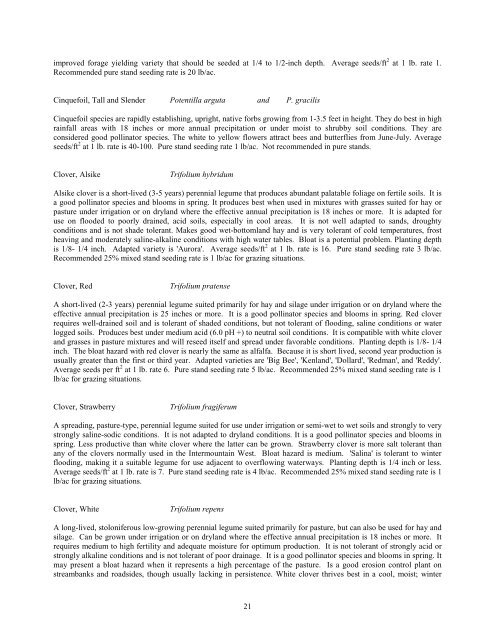Idaho Plant Materials Technical Note No. 24
Idaho Plant Materials Technical Note No. 24
Idaho Plant Materials Technical Note No. 24
You also want an ePaper? Increase the reach of your titles
YUMPU automatically turns print PDFs into web optimized ePapers that Google loves.
improved forage yielding variety that should be seeded at 1/4 to 1/2-inch depth. Average seeds/ft 2 at 1 lb. rate 1.<br />
Recommended pure stand seeding rate is 20 lb/ac.<br />
Cinquefoil, Tall and Slender Potentilla arguta and P. gracilis<br />
Cinquefoil species are rapidly establishing, upright, native forbs growing from 1-3.5 feet in height. They do best in high<br />
rainfall areas with 18 inches or more annual precipitation or under moist to shrubby soil conditions. They are<br />
considered good pollinator species. The white to yellow flowers attract bees and butterflies from June-July. Average<br />
seeds/ft 2 at 1 lb. rate is 40-100. Pure stand seeding rate 1 lb/ac. <strong>No</strong>t recommended in pure stands.<br />
Clover, Alsike<br />
Trifolium hybridum<br />
Alsike clover is a short-lived (3-5 years) perennial legume that produces abundant palatable foliage on fertile soils. It is<br />
a good pollinator species and blooms in spring. It produces best when used in mixtures with grasses suited for hay or<br />
pasture under irrigation or on dryland where the effective annual precipitation is 18 inches or more. It is adapted for<br />
use on flooded to poorly drained, acid soils, especially in cool areas. It is not well adapted to sands, droughty<br />
conditions and is not shade tolerant. Makes good wet-bottomland hay and is very tolerant of cold temperatures, frost<br />
heaving and moderately saline-alkaline conditions with high water tables. Bloat is a potential problem. <strong>Plant</strong>ing depth<br />
is 1/8- 1/4 inch. Adapted variety is 'Aurora'. Average seeds/ft 2 at 1 lb. rate is 16. Pure stand seeding rate 3 lb/ac.<br />
Recommended 25% mixed stand seeding rate is 1 lb/ac for grazing situations.<br />
Clover, Red<br />
Trifolium pratense<br />
A short-lived (2-3 years) perennial legume suited primarily for hay and silage under irrigation or on dryland where the<br />
effective annual precipitation is 25 inches or more. It is a good pollinator species and blooms in spring. Red clover<br />
requires well-drained soil and is tolerant of shaded conditions, but not tolerant of flooding, saline conditions or water<br />
logged soils. Produces best under medium acid (6.0 pH +) to neutral soil conditions. It is compatible with white clover<br />
and grasses in pasture mixtures and will reseed itself and spread under favorable conditions. <strong>Plant</strong>ing depth is 1/8- 1/4<br />
inch. The bloat hazard with red clover is nearly the same as alfalfa. Because it is short lived, second year production is<br />
usually greater than the first or third year. Adapted varieties are 'Big Bee', 'Kenland', 'Dollard', 'Redman', and 'Reddy'.<br />
Average seeds per ft 2 at 1 lb. rate 6. Pure stand seeding rate 5 lb/ac. Recommended 25% mixed stand seeding rate is 1<br />
lb/ac for grazing situations.<br />
Clover, Strawberry<br />
Trifolium fragiferum<br />
A spreading, pasture-type, perennial legume suited for use under irrigation or semi-wet to wet soils and strongly to very<br />
strongly saline-sodic conditions. It is not adapted to dryland conditions. It is a good pollinator species and blooms in<br />
spring. Less productive than white clover where the latter can be grown. Strawberry clover is more salt tolerant than<br />
any of the clovers normally used in the Intermountain West. Bloat hazard is medium. 'Salina' is tolerant to winter<br />
flooding, making it a suitable legume for use adjacent to overflowing waterways. <strong>Plant</strong>ing depth is 1/4 inch or less.<br />
Average seeds/ft 2 at 1 lb. rate is 7. Pure stand seeding rate is 4 lb/ac. Recommended 25% mixed stand seeding rate is 1<br />
lb/ac for grazing situations.<br />
Clover, White<br />
Trifolium repens<br />
A long-lived, stoloniferous low-growing perennial legume suited primarily for pasture, but can also be used for hay and<br />
silage. Can be grown under irrigation or on dryland where the effective annual precipitation is 18 inches or more. It<br />
requires medium to high fertility and adequate moisture for optimum production. It is not tolerant of strongly acid or<br />
strongly alkaline conditions and is not tolerant of poor drainage. It is a good pollinator species and blooms in spring. It<br />
may present a bloat hazard when it represents a high percentage of the pasture. Is a good erosion control plant on<br />
streambanks and roadsides, though usually lacking in persistence. White clover thrives best in a cool, moist; winter<br />
21
















